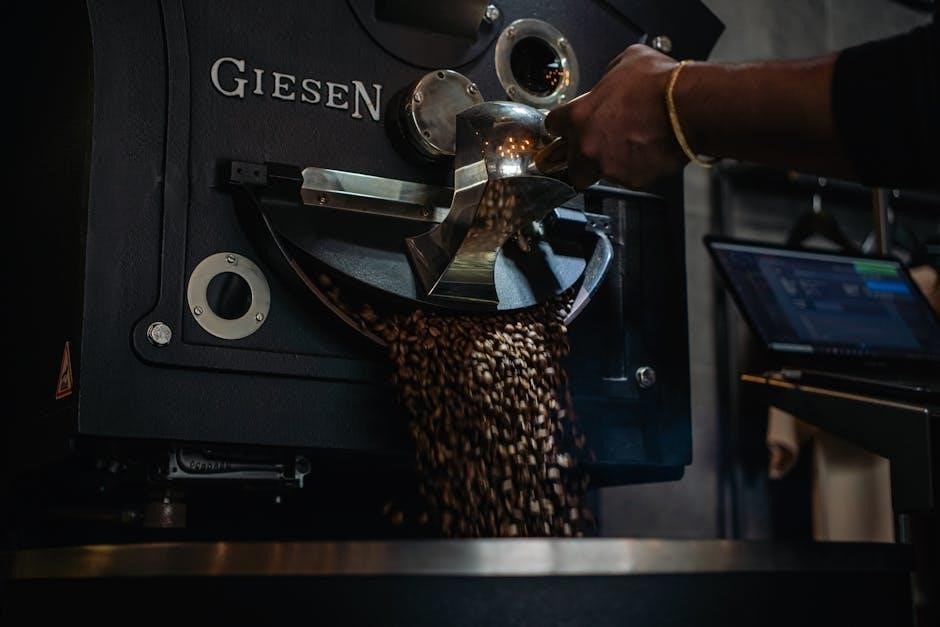Automatic and manual coffee machines offer distinct brewing experiences. Automatic machines provide convenience with integrated grinders and preset options, while manual machines emphasize control and tradition for coffee enthusiasts.
Overview of Coffee Machine Types
Coffee machines are broadly categorized into automatic, manual, and semi-automatic types. Automatic machines offer convenience, with features like integrated grinders and preset settings for various coffee drinks. Manual machines, such as espresso lever machines, require hands-on operation, providing full control over the brewing process. Semi-automatic machines combine elements of both, allowing users to grind, tamp, and brew with some automation. Each type caters to different preferences, whether it’s ease of use, customization, or traditional brewing methods. Understanding these categories helps coffee enthusiasts choose the perfect machine to suit their lifestyle and coffee-making skills. This diversity ensures there’s a machine for every taste and routine.
Importance of Choosing the Right Coffee Machine
Selecting the right coffee machine is crucial for enhancing your coffee experience. It ensures compatibility with your lifestyle, budget, and coffee preferences. Automatic machines save time and are ideal for busy individuals, while manual machines offer precision and control for coffee purists. A well-chosen machine can improve coffee quality, reduce waste, and provide long-term satisfaction. Conversely, the wrong choice may lead to disappointment or underutilization. Factors like daily brewing habits, available space, and maintenance preferences should guide your decision. Investing in the right machine ensures a perfect balance between convenience, flavor, and personal satisfaction, making every cup a delightful experience tailored to your needs.
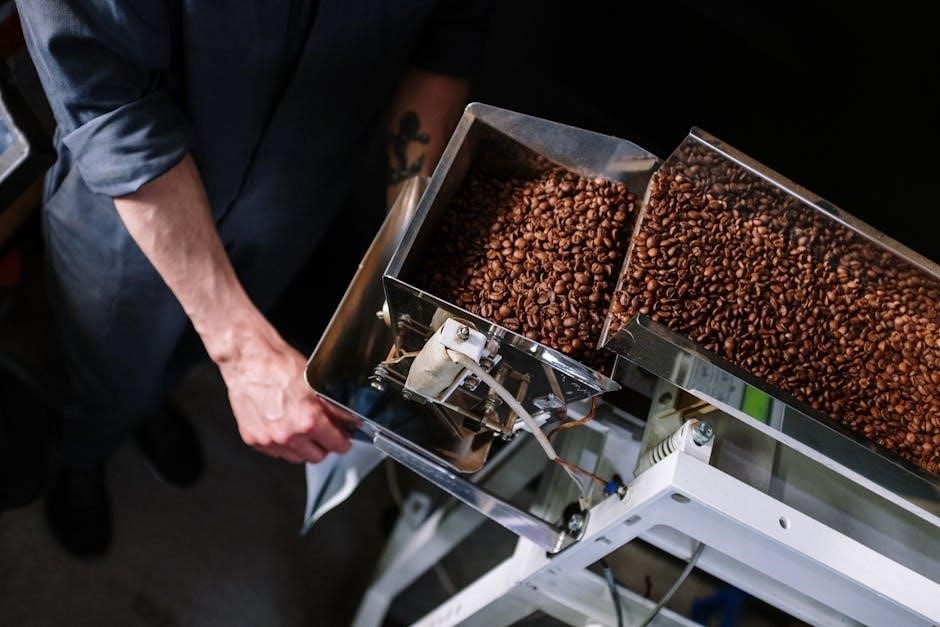
Automatic Coffee Machines
Automatic coffee machines streamline brewing with advanced features like integrated grinders and customizable settings, offering convenience and efficiency for coffee lovers seeking consistent results effortlessly.
How Automatic Coffee Machines Work
Automatic coffee machines operate by automating key steps in the brewing process. They typically feature an integrated grinder, which mills coffee beans to the optimal size. The machine then measures and tamps the ground coffee into a brew group, ensuring consistent extraction. Users can select predefined settings or customize options like strength and volume via a digital interface. Some models include milk frothing systems for lattes and cappuccinos. Once activated, the machine heats water to the ideal temperature and forces it through the coffee grounds, producing a precise shot of espresso or a full pot of coffee. This process minimizes manual effort, offering convenience and efficiency.
Advantages of Automatic Coffee Machines
Automatic coffee machines offer unparalleled convenience, streamlining the brewing process for a quick and effortless experience. They feature integrated grinders, precise temperature control, and pre-set options, ensuring consistent results. Many models include milk frothing systems, allowing users to craft specialty drinks like lattes and cappuccinos at home. Automatic machines are ideal for busy individuals who value time and simplicity, as they minimize manual effort. Additionally, they often come with customizable settings, enabling users to tailor their coffee to personal preferences. Their user-friendly design and advanced features make them a popular choice for those seeking high-quality coffee without the need for extensive barista skills or daily maintenance.
Popular Models of Automatic Coffee Machines
Some of the most popular automatic coffee machines include the Sage Barista Touch, known for its intuitive interface and high-quality espresso. The Jura E8 is another favorite, offering a wide range of customizable drinks and advanced features. The Breville Oracle is praised for its dual boiler system and precise temperature control. Additionally, the De’Longhi Magnifica is a budget-friendly option with an integrated grinder and easy-to-use design. These models stand out for their performance, durability, and ability to cater to diverse coffee preferences. They are highly rated by both novice and experienced users, making them excellent choices for home and office use.

Manual Coffee Machines
Manual coffee machines, like the Gaggia Classic Pro and Flair Espresso Maker, offer portability, durability, and a hands-on brewing experience, ideal for coffee enthusiasts seeking precision and control.
How Manual Coffee Machines Work
Manual coffee machines require users to perform each step of the brewing process. Grounds are placed in a chamber, tamped, and then pressed or forced through with a lever or plunger. Popular models like the Flair Espresso Maker or French press rely on manual effort, offering a hands-on experience. These machines often lack automation, making them portable and simple yet requiring skill and patience. They allow for precise control over brewing parameters, appealing to enthusiasts who value tradition and customization. The process fosters a connection to the craft of coffee-making, making manual machines a favorite among purists and those seeking a tactile brewing method.
Advantages of Manual Coffee Machines
Manual coffee machines offer unparalleled control over brewing parameters, allowing users to tailor each shot to their preference. They are cost-effective, often priced lower than automatic models, and require no electricity, making them portable. Manual machines foster a deeper connection to the coffee-making process, appealing to enthusiasts who value tradition and craftsmanship. They are also quieter and easier to clean compared to automatic machines. Additionally, manual machines like the French press or pour-over brewers often produce unique, rich flavors due to the absence of pressurized systems. This makes them ideal for those seeking a high-quality, customizable, and authentic coffee experience.
Popular Models of Manual Coffee Machines
Manual coffee machines have gained popularity for their simplicity and craftsmanship. The French Press, also known as a cafetière or coffee press, is a classic choice, offering rich and full-bodied coffee. The Hario V60 is a favorite among pour-over enthusiasts, known for its clean and nuanced extraction. The AeroPress is another popular option, combining elements of French press and pour-over for a smooth, espresso-like brew. These models are celebrated for their durability, ease of use, and ability to produce high-quality coffee without electricity. They cater to coffee purists who appreciate the hands-on brewing process and the unique flavors it delivers.
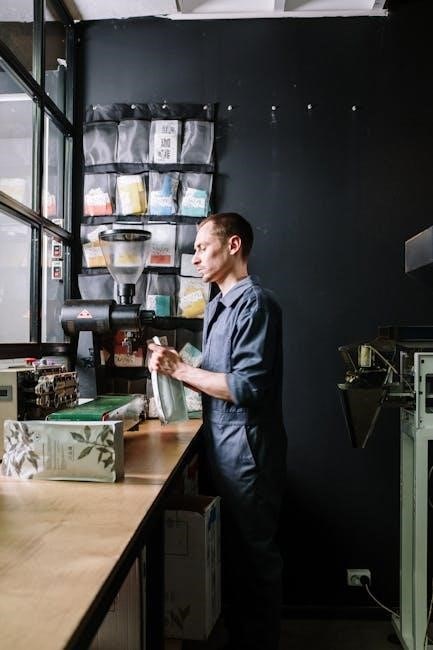
Automatic vs. Manual Coffee Machines
Automatic vs. manual coffee machines: Automatic offers convenience and customization, while manual provides hands-on control and traditional brewing. Choose based on your coffee preferences and lifestyle needs.
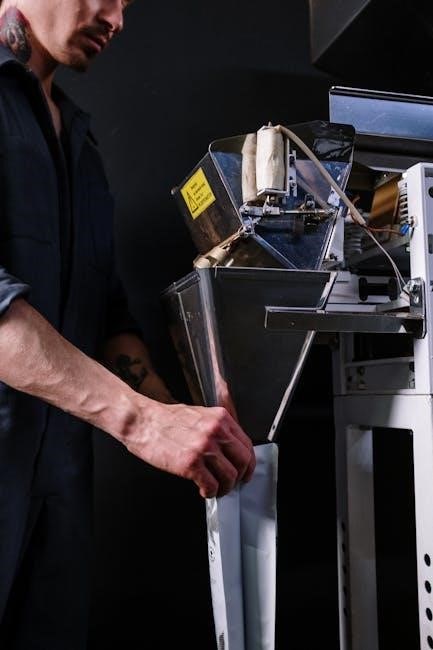
Key Differences in Operation
Automatic coffee machines operate with minimal user input, featuring integrated grinders, preset controls, and automation for tasks like tamping and brewing. Manual machines require hands-on effort, such as grinding beans, tamping, and manually forcing hot water through the grounds, offering full control over the brewing process. Automatic machines are faster and more convenient, ideal for those seeking ease, while manual machines cater to enthusiasts who value precision and tradition. The operational differences reflect distinct approaches to coffee preparation, with automatic machines prioritizing efficiency and manual ones emphasizing craftsmanship and personal touch.
Cost Comparison
Automatic coffee machines generally have a higher upfront cost due to their advanced features, such as integrated grinders and programmable controls. Manual machines are often more affordable, requiring less complex engineering and no automation. Entry-level automatic machines can start around $200, while high-end models may exceed $1,000. Manual machines, like espresso lever models, can range from $100 to $500. However, manual machines may require additional investments in grinders and accessories. Ultimately, automatic machines offer long-term convenience, while manual ones provide cost-effective control for coffee enthusiasts willing to invest time and effort into their brewing process.
Which One is Better for Home Use
The choice between automatic and manual coffee machines for home use depends on personal preferences and lifestyle. Automatic machines are ideal for those seeking convenience and speed, offering features like preset controls and integrated grinders. They are perfect for busy individuals who want a quick, consistent brew without much effort. On the other hand, manual machines provide greater control over the brewing process, appealing to coffee enthusiasts who enjoy the hands-on, traditional method. Manual machines are generally more affordable and require less maintenance. Ultimately, automatic machines suit those prioritizing ease and variety, while manual machines cater to those valuing craftsmanship and customization.
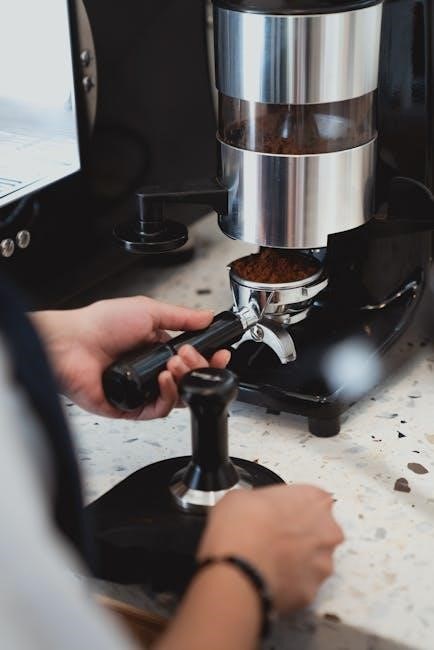
Maintenance and Care
Regular maintenance ensures longevity and optimal performance. Descale automatic machines monthly, clean brew groups, and sharpen grinders. Manual machines require less upkeep but benefit from occasional part inspections.
Cleaning and Descaling
Cleaning and descaling are essential for maintaining coffee machine performance. Automatic machines require regular descaling, typically every 1-3 months, depending on water hardness. Clean the brew group, grinder, and milk system frequently to prevent residue buildup. Manual machines need less maintenance but benefit from occasional cleaning of parts like the portafilter and group head. Descaling is less critical for manual machines unless used with hard water. Proper hygiene practices ensure optimal flavor and longevity of the machine. Regular maintenance prevents limescale buildup and bacterial growth, keeping your coffee tasting fresh and your machine functioning smoothly for years.
Troubleshooting Common Issues
Troubleshooting common issues with coffee machines can save time and extend their lifespan. For automatic machines, issues like poor espresso quality or leaking often stem from improper grind settings or clogged brew groups. Manual machines may face challenges like uneven extraction or stuck portafilters, usually due to incorrect tamping or insufficient coffee. Both types can suffer from scale buildup, leading to reduced performance. Regular descaling and cleaning can prevent many of these problems. Identifying the root cause and addressing it promptly ensures consistent brewing results. Familiarizing yourself with your machine’s specific troubleshooting steps can help maintain optimal functionality and flavor in every cup.
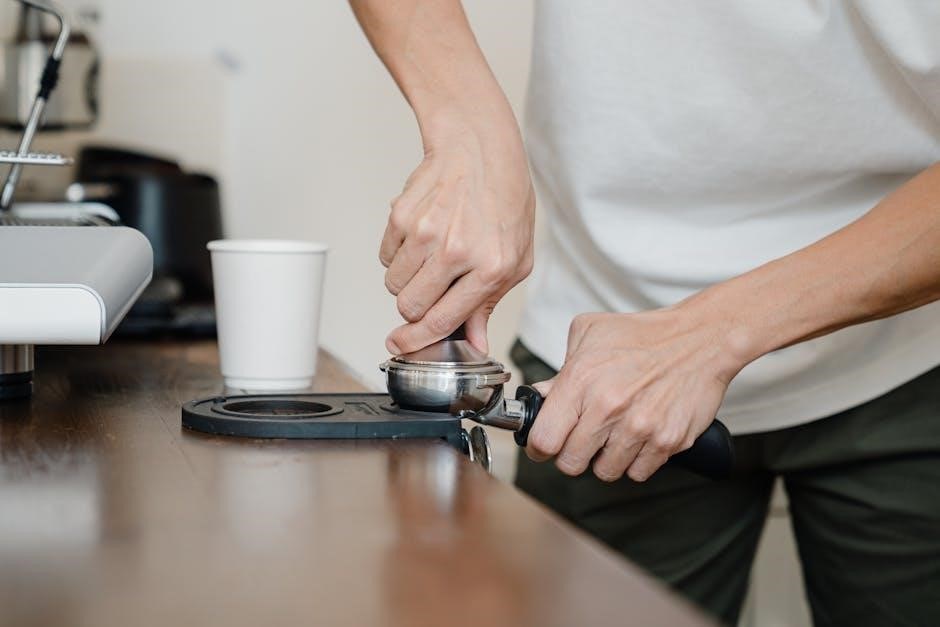
Choosing the Right Machine for Your Needs
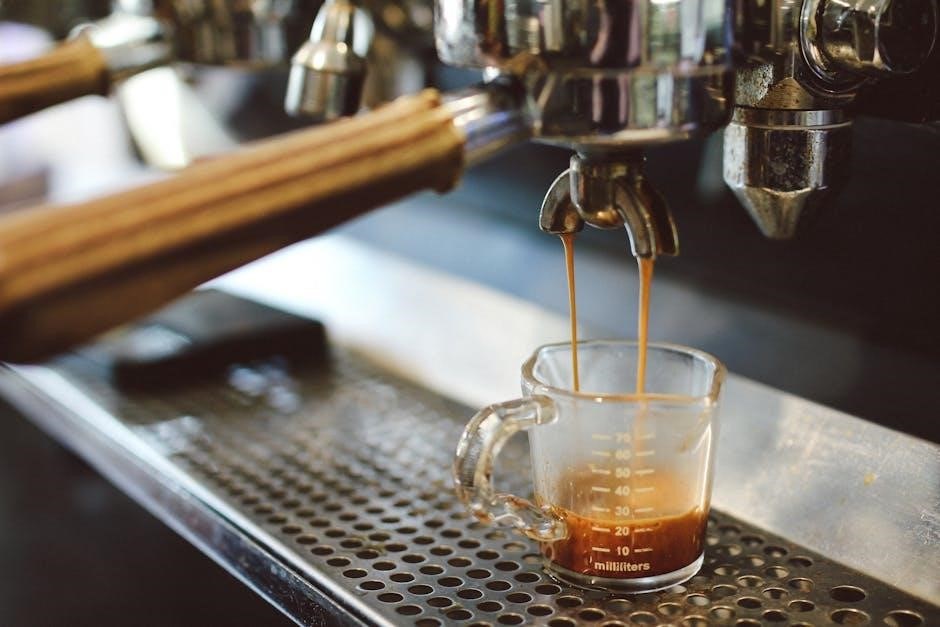
Selecting the right coffee machine depends on your lifestyle, budget, and coffee preferences. Automatic machines offer convenience, while manual machines provide control and customization for enthusiasts.
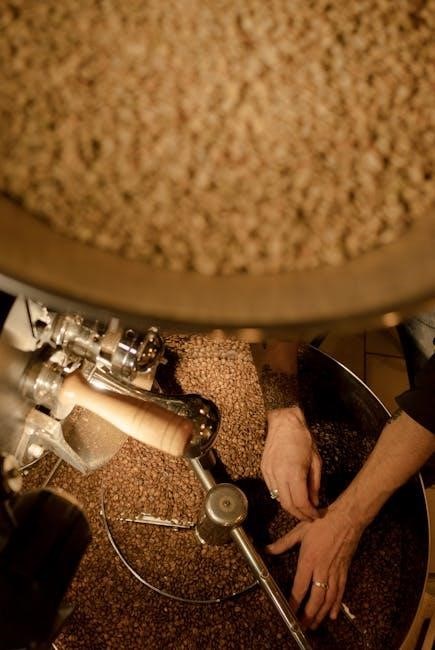
Factors to Consider
When choosing between automatic and manual coffee machines, consider your lifestyle, budget, and coffee preferences. Automatic machines are ideal for convenience, offering preset options and integrated grinders, perfect for busy individuals. They often come with features like customizable drinks and milk-based options, making them versatile for various tastes. Manual machines, on the other hand, provide precise control over brewing parameters, appealing to coffee enthusiasts who value customization and tradition. Budget is another key factor, as automatic machines tend to be more expensive upfront, while manual machines may require more time and effort but can be more cost-effective in the long run. Additionally, space and maintenance should be considered, as automatic machines are often larger and require regular descaling, whereas manual machines are more compact and easier to clean. Ultimately, your choice should align with your daily routine and how much you value convenience versus control in your coffee-making process.
Recommendations for Different Users
For busy individuals seeking convenience, automatic machines are ideal, offering quick and consistent results with minimal effort. Coffee enthusiasts who value precision and customization may prefer manual machines, allowing them to fine-tune brewing parameters. Budget-conscious users can opt for entry-level manual machines or compact automatic models. Those who enjoy both espresso and milk-based drinks should consider automatic machines with built-in steam wands. For occasional use, manual machines like the AeroPress or pour-over are cost-effective and easy to store. Lastly, for commercial settings or heavy use, high-end automatic machines with advanced features are recommended. Choose based on your lifestyle, budget, and coffee preferences for the best experience.
